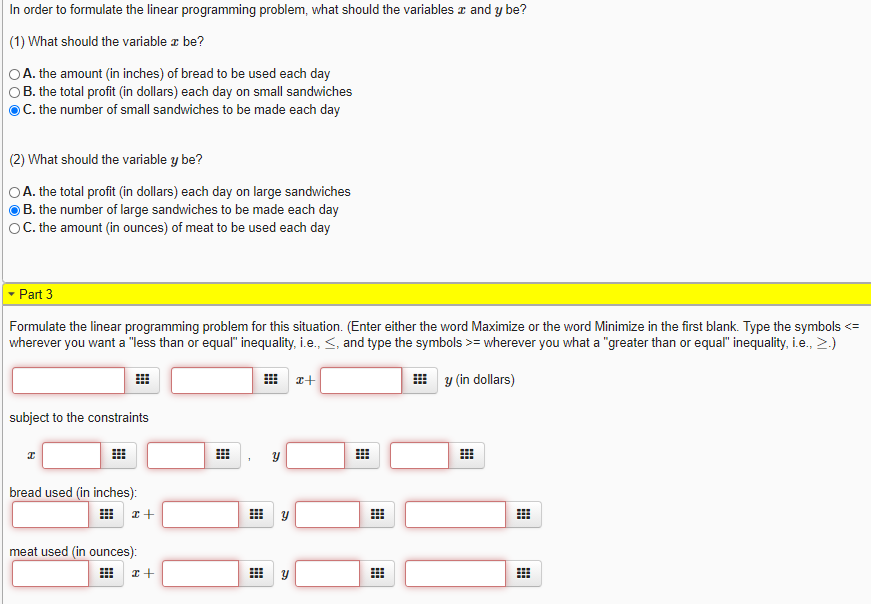Rework problem 1 in section 1 of Chapter 7 of your textbook, about Sam's Deli, using the following data. Assume that each small sandwich uses 4 inches of bread and 3 ounces of meat, and that each large sandwich uses 12 inches of bread and 6 ounces of meat. Assume also that the Deli has on hand each day 115 feet of bread and 25 pounds of meat. ASsume also that the profit on each small sandwich is $1.00 and the profit on each large sandwich is $1.50. How many sandwiches of each size should the Deli make in order maximize its profit?
Rework problem 1 in section 1 of Chapter 7 of your textbook, about Sam's Deli, using the following data. Assume that each small sandwich uses 4 inches of bread and 3 ounces of meat, and that each large sandwich uses 12 inches of bread and 6 ounces of meat. Assume also that the Deli has on hand each day 115 feet of bread and 25 pounds of meat. ASsume also that the profit on each small sandwich is $1.00 and the profit on each large sandwich is $1.50. How many sandwiches of each size should the Deli make in order maximize its profit?
Algebra and Trigonometry (MindTap Course List)
4th Edition
ISBN:9781305071742
Author:James Stewart, Lothar Redlin, Saleem Watson
Publisher:James Stewart, Lothar Redlin, Saleem Watson
Chapter10: Systems Of Equations And Inequalities
Section10.FOM: Focus On Modeling: Linear Programming
Problem 14P
Related questions
Topic Video
Question
I need help with part 3

Transcribed Image Text:Part 1
Rework problem 1 in section 1 of Chapter 7 of your textbook, about Sam's Deli, using the following data. Assume that each small sandwich
uses 4 inches of bread and 3 ounces of meat, and that each large sandwich uses 12 inches of bread and 6 ounces of meat. Assume also that
the Deli has on hand each day 115 feet of bread and 25 pounds of meat. Assume also that the profit on each small sandwich is $1.00 and the
profit on each large sandwich is $1.50. How many sandwiches of each size should the Deli make in order maximize its profit?
When you formulate a linear programming problem to solve this problem, how many variables, how many constraints (both implicit and
explicit), and how many objective functions should you have?
Number of variables: 2
Number of constraints: 4
Number of objective functions: 1

Transcribed Image Text:In order to formulate the linear programming problem, what should the variables z and y be?
(1) What should the variable a be?
OA. the amount (in inches) of bread to be used each day
OB. the total profit (in dollars) each day on small sandwiches
OC. the number of small sandwiches to be made each day
(2) What should the variable y be?
OA. the total profit (in dollars) each day on large sandwiches
B. the number of large sandwiches to be made each day
OC. the amount (in ounces) of meat to be used each day
- Part 3
Formulate the linear programming problem for this situation. (Enter either the word Maximize or the word Minimize in the first blank. Type the symbols <=
wherever you want a "less than or equal" inequality, i.e., <, and type the symbols >= wherever you what a "greater than or equal" inequality, i.e., >.)
y (in dollars)
subject to the constraints
bread used (in inches):
meat used (in ounces):
田
నా
Expert Solution
This question has been solved!
Explore an expertly crafted, step-by-step solution for a thorough understanding of key concepts.
This is a popular solution!
Trending now
This is a popular solution!
Step by step
Solved in 3 steps

Knowledge Booster
Learn more about
Need a deep-dive on the concept behind this application? Look no further. Learn more about this topic, advanced-math and related others by exploring similar questions and additional content below.Recommended textbooks for you

Algebra and Trigonometry (MindTap Course List)
Algebra
ISBN:
9781305071742
Author:
James Stewart, Lothar Redlin, Saleem Watson
Publisher:
Cengage Learning

Algebra and Trigonometry (MindTap Course List)
Algebra
ISBN:
9781305071742
Author:
James Stewart, Lothar Redlin, Saleem Watson
Publisher:
Cengage Learning